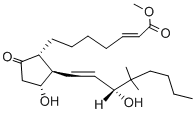
gemeprost
- Product Namegemeprost
- CAS64318-79-2
- CBNumberCB0875558
- MFC23H38O5
- MW394.548
- EINECS264-775-9
- MDL NumberMFCD00867892
- MOL File64318-79-2.mol
- MSDS FileSDS
Chemical Properties
| Boiling point | 438.73°C (rough estimate) |
| Density | 1.0380 (rough estimate) |
| refractive index | 1.5800 (estimate) |
| pka | 13.84±0.60(Predicted) |
| FDA UNII | 45KZB1FOLS |
| ATC code | G02AD03 |
Safety
| Symbol(GHS) |
 
|
| Signal word | Danger |
| Hazard statements | H332-H360-H301-H312 |
| Precautionary statements | P261-P271-P304+P340-P312-P264-P270-P301+P310-P321-P330-P405-P501-P280-P302+P352-P312-P322-P363-P501 |
| RIDADR | 3249 |
| HazardClass | 6.1(b) |
| PackingGroup | III |
